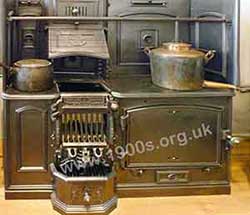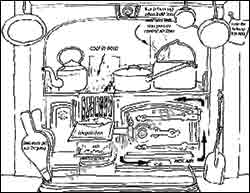The Victorian range cooker
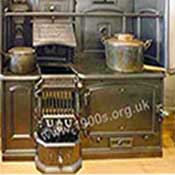
Kitchen ranges, also known as 'kitcheners', 'cooking ranges' or just 'ranges', were what everyone cooked with in Victorian and Edwardian times - unless of course they were still using the older open fire cooking. Some such ranges were still in use even after electric and gas ovens became available, and a large number have survived in museums and stately homes. They came in different sizes and shapes, down to the smallest versions known as kitchen fires. This page describes the common key features and the hard work that went into using them. It also provides a large number of photos illustrating the variety, some at a high resolution. There is particular reference to the fire, the fuel and the ovens.
____
Extracted from the memoirs of the webmaster's mother (1906-2002) and edited by the webmaster with further research and firsthand contributions from others
Parts of a kitchen range
Cooking ranges were essentially cast iron, like the cooking pots used on them, although there could be steel trims.
They came in many shapes and sizes, suitable for different sized rooms, different sized families and different types of cooking. In spite of their differences, though, all had the same essential parts.
The following image and sketch show the main parts of a range suitable for a fairly large and comparatively well-off family. In the sketch, the positions of the kettle, the various pots and the hot fire speak for themselves but the following are specifically labelled: where the coal went in with its hinged door; where the ash fell through; the flow of hot air; the dampers to control the air flow and hence the cooking temperature and the bellows to get the fire going; the cloth for holding the hot pots.
Click/tap for larger images showing detail
The ovens, fire and fuel
The fire which heated the one or more ovens ran on coal which was the mainstay of all heating at the time. Whenever an oven was needed for cooking or baking, the fire had to be stoked up well in advance to bring the oven up to a suitable temperature. Recognising that suitable temperature required skill and experience because there were no oven thermostats. When a range was in use, it was usual to keep the fire just smouldering and then use bellows, a poker and more coal to bring it back to life when wanted. This meant that working near a kitchen range could be hot, sweaty and very uncomfortable. It was no wonder that women preferred where possible to use the smaller oven of the kitchen fire.
Emptying the ash, loading more coal onto the fire and keeping the range clean all required hard work, as described by children who had to help with it - see the boxes below.
The variety of shapes and sizes of kitchen ranges
The following photos give an idea of the wide variety of shapes and sizes of these ranges, but a word of warning: Although an essential part of all kitchen ranges was their chimneys to let the smoke from the coal fires to escape, this is not always obvious in the photos for two reasons:
- One reason is that the ranges which were photographed in their original positions were normally set into alcoves, such that the chimney, or most of it, was hidden inside a wall.
- The other reason is that most of the ranges which were photographed in museums were relocated there without their chimneys, just to show style and form but not to work.
Ranges and kitchen fires photographed in old houses and museums
In my visits to old houses and museums, I have seen a wide variety of kitchen ranges. Here is a selection:
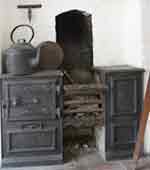
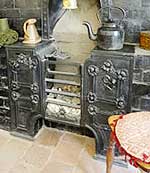
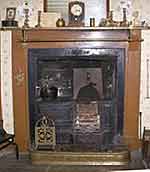
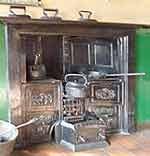
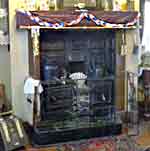
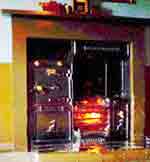
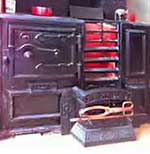
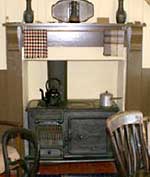
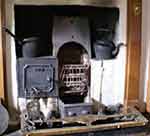
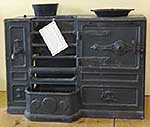
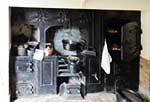
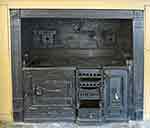
Victorian and Edwardian coal-fired kitchen ranges still existed in many old houses until the 1960s and 70s and even later.
Later kitchen ranges
Later range designs incorporated a 'back boiler' which provided hot water on tap. These, however, could explode if pipework became blocked - and frozen water in pipes wasn't unusual!
Albert Smith
How a kitchen range was cleaned
Using a kitchen range involved a lot of work which is described on the page about a kitchen fire which was essentially the same as a small range. What is not described there, but is described here is cleaning the kitchen range.
As every range was a cast-iron, it was kept clean with a polish called 'black lead' which was specially for cleaning and shining cast iron. It came in a tin with the picture of a Zebra on.
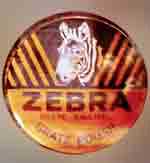
Tin of 'black lead' used for cleaning and polishing cast iron cookers. Photographed at the Cambridge and County Folk Museum.
My mother's written recollections make it clear that the outer rims of the range in her home were steel and kept bright with emery paper.
Who cleaned the kitchen range?
As an older child it was one of my daily jobs to 'black-lead' the kitchen range, once I had cleared out ashes and relaid the fire. Then I had to polish up the exposed metal with wire wool.
Albert Smith
Why and how the steel trim was cleaned
The steel rims were the trim edges on the top plate of the range and on some other edges like doors. You may be able to spot them from the some of the above photos. Unlike the main structure which was normally black cast iron, the rims were steel. As there was no stainless steel in those days, steps had to be taken to prevent rust building up on the steel. So the rims were burnished, either with emery paper which is like very fine sandpaper, or thick wire wool, rather like a Brillo pad but without the soap.
Martin Green
I understand that, more generally, the insides of the ovens were kept clean by heating them to a high temperature to burn off the soot. Some insides of ovens may have been removable for cleaning purposes.
If you can add anything to this page or provide a photo, I would be pleased if you would contact me.
Text and images are copyright
sources: early 20th century material
sources: ww2 home front and other material
contact
the webmaster/author/researcher/editor
privacy policy


